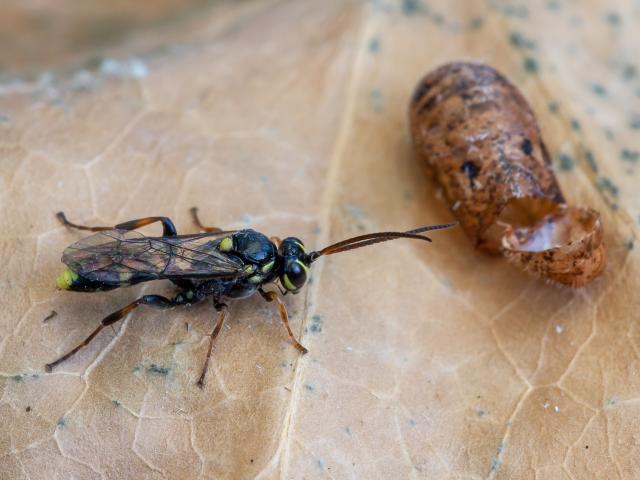Large White larva with Cotesia glomerata cocoons - Vince Massimo
The birds are singing, the sun is out, and you’ve just spotted a caterpillar on a leaf, vibrant green and speckled with black. Beautiful, you think. That is, until you take a closer look…
This caterpillar doesn’t seem quite right. Its skin bulges, its body twitches, and it’s almost like something inside is trying to get out – you’ve found a zombie!
This caterpillar has fallen victim to a parasitoid wasp.
Having injected its eggs into the caterpillar, along with a virus which hijacks the caterpillar’s immune system, the wasp has created the perfect home for its offspring – one that provides protection, food and grows as the larvae grow.
For the past two weeks, the wasp larvae have been feasting on the caterpillar victim from the inside out, and now it’s time for them to emerge from the nightmarish nursery.
Having paralysed the caterpillar and scraped at its skin to weaken it, they erupt from the body in a gruesome mass of grubs and begin spinning protective cocoons in which to pupate.
You might think the poor caterpillar’s job is now done, but the cocoons need a bodyguard, and who better than their former obliging host? The “zombie” caterpillar spins a silken mat over the wasp cocoons and stands guard until the adult wasps emerge, at which point the wasps fly off to begin the cycle again…
There are nearly 6,500 species of parasitoid wasps in Britain, and numerous parasitoid flies. And moths are just as susceptible to a case of body snatching as butterflies.
Some wasps target specific species of butterfly or moth. Listrodomus nycthemerus, for example, is entirely dependent on the Holly Blue butterfly – if numbers of Holly Blues fall, then so do numbers of the wasp. Others are less picky, targeting families of butterflies or moths, or multiple butterflies and moths from different families.

And it’s not just caterpillars which may fall victim to parasitoids – butterfly eggs and pupa might also harbour some surprises for those watching to see who emerges.
But do the butterflies have any defence against the invaders?
Well, initial research suggests that there are insect-infecting viruses which may actually help butterflies fend off parasitoid wasps. If the butterflies survive one of the viruses, they may take on a gene which protects them from future attacks by wasps.
And the Tobacco Hawk-moth, an American moth species, has come up with its own method of protecting its offspring from parasitoid wasps. The female moth prefers to lay its eggs on its caterpillar foodplant, Jimsonweed, when the plant is infested with Three-lined Potato Beetles. The wasp, seeking out Tobacco Hawk-moth caterpillars to become its next victims, avoids plants where the Three-lined Potato Beetles are present – leaving the Tobacco Hawk-moth young safe and undisturbed.
However, there’s a lot more to be understood about the gruesome but fascinating relationship between parasitoid wasps and their butterfly hosts.
So, next time you’re out in nature, remember, beware of zombies.

